 |
Picks is a monthly sampling of Japan's art scene, offering commentary by a variety of reviewers about exhibitions at museums and galleries in recent weeks, with an emphasis on contemporary art by young artists. |
 |
 |
|
|
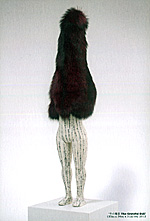 |
 |
|
| Miki Taira: Tales of Living Beings |
| 3 March - 1 April 2012 |
Tokyo Gallery
(Tokyo) |
 |
| Back in an age when human beings were inseparable from the rest of nature, people readily metamorphosed into animals, and animals into people. Taira gathers orally transmitted folktales from various parts of Japan that embody this primitive worldview, and converts them into sculptures covered with calligraphic script. On one level her objects may appear as somewhat amateurish installations, but they invoke sensations that have long been missing from contemporary art. Still in her twenties, Taira majored in calligraphy at college and won the Geisai Silver Award for young artists in 2006. |
|
|
 |
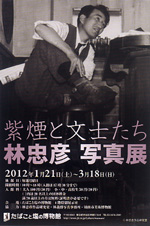 |
 |
|
| Tadahiko Hayashi: Tobacco Smoke and Men of Letters |
| 21 February - 18 March 2012 |
Tobacco & Salt Museum
(Tokyo) |
 |
| The Tobacco & Salt Museum revisits the late (1918-90) Hayashi's "Literati" series, predictably selecting only those portraits that feature famous authors smoking cigarettes. Then again, since none of these photos were taken later than the 1970s, it's a safe bet that nearly all of Hayashi's subjects smoked. Whether they are lost in thought, drinking and gabbing, or staring at a sheet of manuscript paper, the smoke curling around their heads is part and parcel of the Japanese image of literati. As these shots attest, however, the cigarette is not only an indispensable prop; the smoke also softens the ambient light of the image. |
|
|
|
|

|
 |
 |
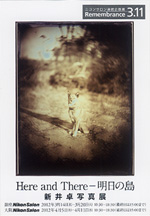 |
 |
| Takashi Arai: Here and There - Tomorrow's Islands |
| 14 - 20 March 2012 |
Ginza Nikon Salon
(Tokyo) |
 |
A devotee of the daguerreotype, with its uniquely beautiful melding of positive and negative, Arai shot photos using this demanding technique between April 2011 and February 2012 in Fukushima towns like Minamisoma, Iitate, and Kawauchi, all within the "voluntary evacuation" zone surrounding the crippled nuclear power plants. Complementing his images of the local landscape, residents, family pets, and flowers are other daguerreotypes of calendars found in the cabins of the Fukuryu Maru (Lucky Dragon), the fishing boat whose crewmembers were exposed to fallout from the nuclear test at Bikini Atoll in 1954. The 15 prints on display are part of Nikon Salon's "Remembrance 3.11" series.
|
|
|
 |
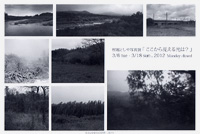 |
 |
| Toshiya Murakoshi: The Light You See from Here |
|
|
TAP Gallery
(Tokyo)
|
 |
| Photographer Murakoshi hails from Sukagawa, just outside Fukushima's nuclear no-go zone. But this series of landscapes from his home turf was not shot after the March 2011 accident but during the seven years preceding it. The images seem infused with the damp of the region's wetlands and forests. One senses Murakoshi's determination to record the quietly immutable character of this land, changeless despite what human folly may do to it. |
|
|
|
|
|
|
|

|
 |
 |
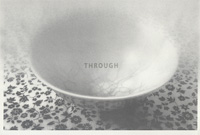 |
 |
| Nobuaki Onishi: Through |
| 18 February - 17 March 2012 |
Gallery Nomart
(Osaka) |
 |
| This show introduces Onishi's "through-printing" technique, a form of silkscreening in which the ink is blown from a distance to produce the image. By adjusting that distance the artist is able to create areas of the image that resemble a photograph shot through a filter. |
|
|
 |
 |
| Yuko Kanamori: Memoriae |
| 27 February - 17 March 2012 |
Gallery Hosokawa
(Osaka) |
 |
| Kanamori's multimedia installations invariably charm with their original, gently astonishing takes on the minutiae of daily life. In this exhibit of new works she introduces a mix of videos and objects, the latter including white sheets of paper punched into lace patterns and an origami boat floating on the blue endpaper of a book. The variegated images scattered across the gallery space induce diverse flights of the imagination. |
|

|
 |
 |
 |
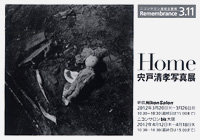 |
|
| Kiyotaka Shishido: Home |
| 20 - 26 March 2012 |
Shinjuku Nikon Salon
(Tokyo) |
 |
| The final installment of Nikon Salon's "Remembrance 3.11" series, Shishido's show reflects the photographer's own struggle to come to terms with the disaster. He was in his Sendai office when the earthquake struck the city hard; four days later he ventured out to the nearby coast and recorded the devastation in the Yuriage district of Natori city, which was nearly wiped out by the tsunami. For some time afterward he remained torn between an aversion to revisiting that landscape and a sense of obligation to continue chronicling it. One can feel his ambivalence in these works, but also a tentative awakening of hope, of life gradually returning to the ruined land. |
|
|
 |
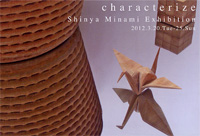 |
 |
| Shinya Minami: Characterize |
| 20 - 25 March 2012 |
Art Space Niji
(Kyoto) |
 |
| Minami's everyday objects -- an origami crane, a balloon, a Rubik's Cube, a plastic drink bottle, a paper milk container, a donut, a basket -- sit on a reflective display table. All are made of wood. The objects' textures and placement trigger sensations of the passage of time and thoughts about the capriciousness of the senses with which we perceive objects. |
|
|
|
|
|
|
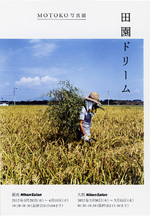 |
 |
| Motoko: A rural dream |
| 28 March - 10 April 2012 |
Ginza Nikon Salon
(Tokyo) |
 |
| Part of the photographer's "Rural Dream Project," these scenes of nature, farming activities, and festival rites in the area around Lake Biwa are truly archetypal views of life in Japan. Motoko's guileless eye provides a pleasant and thoroughgoing look at the everyday lives of inhabitants of the region.
|
|
 |
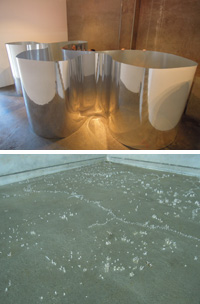 |
 |
| studio velocity: fluctuation |
| 31 March - 8 April 2012 |
Masayoshi Suzuki Gallery
(Aichi)
|
 |
| On the ground floor of the gallery, large, shimmering, filmlike structures reflect the surrounding ambience. In the basement one finds tiny, delicate architectural models placed in a "landscape" created from the cracks in the floor. Kentaro Kurihara and Miho Iwatsuki, the young architect duo that form studio velocity, are protégés of Junya Ishigami and are known for the imaginative dwellings they have designed in the greater Nagoya area. Here their fragile constructions bridge the gap between architecture and art. An international debut is in the works as they plan to participate in this year's Venice Biennale. |
|
|
|
|
 |
|